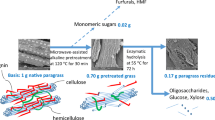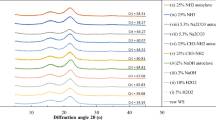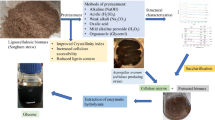Abstract
The present study investigated the ability of pressurized microwave pretreatment to convert softwood lignocellulose to fermentable monosaccharides. Norway spruce lignocellulose was subjected to microwave pretreatment (600 and 1200 W) under high pressure at different temperatures. Microwave pretreatment at mild acid concentrations (0.05–0.1 % H2SO4), temperatures of 170 and 200 °C, and a very short incubation time (5 min) released 84–100 % of hemicellulosic monosaccharides (mannose, galactose, and xylose). In addition, minimal amounts of degradation products (5-(hydroxymethyl)-2-furaldehyde, levulinic acid) were formed. The highest yield of fermentable sugars was 75 %, after both the pressurized microwave pretreatment with conditions 0.05 % H2SO4/600 W/200 °C/5 min and enzymatic hydrolysis with 20 FPU Celluclast 1.5 L, 400 nkat of Novozyme 188, and polyethyleneglycol (PEG) 4000 (0.3 g/g of pretreated material). Results showed that already 0.05 % H2SO4 used in microwave pretreatment could effectively liberate hemicellulose monosaccharides without serious monosaccharide degradation and form a basis for enzymatic hydrolysis.



Similar content being viewed by others
References
Zhu JY, Pan XJ (2010) Woody Biomass pretreatment for cellulosic ethanol production: technology and energy consumption evaluation. Bioresour Technol 101:4992–5002
Mosier N, Wyman C, Dale B, Elander R, Lee YY, Holtzapple M, Ladisch M (2005) Features of promising technologies for pretreatment of lignocellulosic biomass. Bioresour Technol 96:673–686
Iakovlev M, van Heiningen A (2012) Efficient fractionation of spruce by SO2-Ethanol-Water treatment: closed mass balances for carbohydrates and sulfur. ChemSusChem 5:1625–1637
Chundawat SPS, Beckham GT, Himmel ME, Dale BE (2011) Deconstruction of lignocellulosic biomass to fuels and chemicals. Ann Rev Chem Biomol Eng 2:121–145
Brodeur G, Yau E, Badal K, Collier J, Ramachandran KB, Ramakrishnan S (2011) Chemical and physicochemical pretreatment of lignocellulosic biomass: a review. Enzyme Research ID 787532 doi:10.4061/2011/787532
Alvira P, Tomás-Pejó E, Ballesteros M, Negro MJ (2010) Pretreatment technologies for an efficient bioethanol production process based on enzymatic hydrolysis: a review. Bioresour Technol 101:4851–4861
Shuai L, Yang Q, Zhu JY, Lu FC, Weimer PJ, Ralph J, Pan XJ (2010) Comparative study of SPORL and dilute-acid pretreatments of spruce for cellulosic ethanol production. Bioresour Technol 101:3106–3114
Söderström J, Pilcher L, Galbe M, Zacchi G (2003) Two-step steam pretreatment of soft wood by dilute H2SO4 impregnation for ethanol production. Biomass Bioenergy 24:475–486
Oliva JM, Sáez F, Ballesteros I, González A, José Negro M, Manzanares P, Ballesteros M (2003) Effect of lignocellulosic degradation compounds from steam explosion pretreatment on ethanol fermentation by thermotolerant yeast Kluyveromyces marxianus. Appl Biochem Biotechnol 105–108:141–153
De Souza ROMA (2015) Theoretical aspect of microwave irradiation practices. In: Fang Z, Smith Jr. RL, Qi X. (Eds.) Production of biofuels and chemicals with microwave, 1st edn. Springer. pp. 3–16
Chen WH, Tu YJ, Herng-Kuang S (2011) Disruption of sugarcane bagasse lignocellulosic structure by means of dilute sulfuric acid pretreatment with microwave-assisted heating. Appl Energy 88:2726–2734
Caddick S (1995) Microwave-assisted organic reactions. Tetrahedron 51(38):10403–10432
Ooshima H, Aso K, Harano Y (1984) Microwave treatment of cellulosic materials for their enzymatic hydrolysis. Biotechnol Lett 6(5):289–294
U.S Department of Energy (2007) Increasing yield and quality of low-temperature, low-alkali Kraft cooks with microwave pretreatment. Industrial Technologies Program. http://infohouse.p2ric.org/ref/49/48158.pdf Accessed 30.9.2015
Binod P, Satyanagalakshmi K, Sindhu R, Usha Janu K, Sukumaran RK, Pandley A (2012) Short duration microwave assisted pretreatment enhances the enzymatic saccharification and fermentable sugar yield from sugarcane bagasse. Renew Energy 37:109–116
Lu X, Xi B, Zhang Y, Angelidaki I (2011) Microwave pretreatment of rape straw for bioethanol production: focus on energy efficiency. Bioresour Technol 102:7937–7940
Saha BC, Biswas A, Cotta MA (2008) Microwave pretreatment, enzymatic saccharification and fermentation of wheat straw to ethanol. J Biobased Mater Bioenergy 2:210–217
Keshwani DR, Cheng JJ, Burns JC, Li L, Chiang V (2007) Microwave pretreatment of switchgrass to enhance enzymatic hydrolysis. ASABE Annual Meeting Paper No. 077127
Lundqvist J, Teleman A, June L, Zacchi G, Dahlman O, Tjerneld F, Stålbrand H (2002) Isolation and characterization of galactoglucomannan from spruce (Picea abies). Carbohydr Polym 48:29–39
Xue BL, Li MF, Xu F, Sun RC, Joens G (2012) Microwave-enhanced alkali treatment of Pinus yunnanensis: physiochemical characterization of the dissolved lignins. Ind Crop Prod 36:209–216
Azuma J, Tanaka F, Koshijima T (1984) Enhancement of enzymatic susceptibility of lignocellulosic wastes by microwave irradiation. J Ferment Technol 62(4):377–384
Jensen JR, Morinelly JE, Gossen KR, Broseur-Campbell MJ, Shonnard DR (2010) Effects of dilute acid pretreatment conditions on enzymatic hydrolysis monomer and oligomer sugar yields for aspen, balsam and switchgrass. Bioresour Technol 101:2317–2325
Yemis O, Mazza G (2011) Acid-catalysed conversion of xylose, xylan and straw into furfural by microwave-assisted reaction. Bioresour Technol 102:7371–7378
Gong G, Liu D, Huang Y (2010) Microwave-assisted organic acid pretreatment for enzymatic hydrolysis of rice straw. Biosyst Eng 107:67–73
Sluiter A., Hames B, Ruiz R., Scarlata C, Sluiter J, Templeton D, Crocker D (2010) Determination of structural carbohydrates and lignin in biomass. Technical Report NREL/TP-510-42618
Yang M, Kuittinen S, Zhang J, Keinänen M, Pappinen A (2013) Effect of d ilute acid pretreatment on the conversion of barley straw with grains to fermentable sugars. Bioresour Technol 146:444–450
Hayes DJM (2012) Development of near infrared spectroscopy models for the quantitative prediction of the lignocellulose components of wet Miscanthus samples. Bioresour Technol 119:393–405
Chum HL, Johnson DK, Black SK, Overend RP (1990) Pretreatment-catalyst effects of the combined severity parameter. Appl Biochem Biotechnol 24(25):1–14
Palm M, Zacchi G (2003) Extraction of hemicellulosic oligosaccharides from Norway spruce using microwave oven or steam treatment. Biomacromolecules 4:617–623
Monavari S, Galbe M, Zacchi G (2009) Impact of impregnation time and chip size on sugar yield in pretreatment of softwood for ethanol production. Bioresour Technol 100:6312–6316
Lan TQ, Gleisner R, Zhu JY, Dien BS, Hector RE (2013) High titer ethanol production from SPORL-pretreated lodgepole pine by simultaneous enzymatic saccharification and combined fermentation. Bioresour Technol 127:291–297
Larsson S, Palmqvist E, Hahn-Hägerdahl B, Tengborg C, Stenberg K, Zacchi G, Nilvebrant NO (1999) The generation of fermentation inhibitors during dilute acid hydrolysis of softwood. Enzym Microb Technol 24:151–159
Pedersen M, Meyer AS (2010) Lignocellulose pretreatment severity—relating pH to biomatrix opening. New Biotechnol 27(6):739–750
Palmqvist E, Hahn-Hägerdal B (2000) Fermentation of lignocellulosic hydrolysates II: inhibitors and mechanisms of inhibition. Bioresour Technol 74:25–33
Alén R (ed.) (2011) Biorefining of forest resources. Papermaking Science and Technology. Book 20. Bookwell
Sjöström E (1981) Wood chemistry fundamentals and applications. Academic Press
Kumar L, Chandra R, Chung PA, Saddler J (2010) Can the same steam pretreatment conditions be used for most softwoods to achieve good, enzymatic hydrolysis and sugar yields? Bioresour Technol 101:7827–7833
Pan XJ, Xie D, Gilkes N, Gregg DJ, Saddler JN (2005) Strategies to enhance the enzymatic hydrolysis of pretreated softwood with high residual lignin content. Appl Biochem Biotechnol 121–124:1069–1079
Ewanick SM, Bura R, Saddler JN (2007) Acid-catalyzed steam pretreatment of lodgepole pine and subsequent enzymatic hydrolysis and fermentation to ethanol. Biotechnol Bioeng 98:737–746
Wu MM, Chang K, Gregg DJ, Boussaid A, Beatson RP, Saddler JN (1999) Optimization of steam explosion to enhance hemicellulose recovery and enzymatic hydrolysis of cellulose in softwoods. Appl Biochem Biotechnol 77(9):47–54
Kumar L, Arantes V, Chandra R, Saddler J (2012) The lignin present in steam pretreated softwood binds enzymes and limits cellulose accessibility. Bioresour Technol 103:201–208
Rahikainen J, Mikander S, Marjamaa K, Tamminen T, Lappas A, Viikari L, Kruus K (2011) Inhibition of enzymatic hydrolysis by residual lignins from softwood—study of enzyme binding and inactivation on lignin-rich surface. Biotechnol Bioeng 108(12):2823–2834. doi:10.1002/bit.23242
Yang B, Wyman CE (2006) BSA Treatment to enhance enzymatic hydrolysis of cellulose in lignin containing substrates. Biotechnol Bioeng 94(4):611–617
Acknowledgments
The study was part of the “Renewable transportation fuels in North Karelia—development of expertise” project funded by the European Structural Funds and the “New business opportunities for bioenergy producers” project funded by the European Agricultural Fund for Rural Development.
Author information
Authors and Affiliations
Corresponding author
Rights and permissions
About this article
Cite this article
Kuittinen, S., Rodriguez, Y.P., Yang, M. et al. Effect of Microwave-Assisted Pretreatment Conditions on Hemicellulose Conversion and Enzymatic Hydrolysis of Norway Spruce. Bioenerg. Res. 9, 344–354 (2016). https://doi.org/10.1007/s12155-015-9696-9
Published:
Issue Date:
DOI: https://doi.org/10.1007/s12155-015-9696-9




